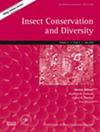中国四川椑科、鞘翅目和寄生虫三营养群落的网络结构和分类组成
IF 3.2
2区 农林科学
Q1 ENTOMOLOGY
引用次数: 0
摘要
昆虫群落生态学中的一个关键问题是,寄生虫群落是否由其食草动物宿主的食用植物构成。以前的研究表明,寄主植物特性对栎树-鞘翅目昆虫之间相互作用的预测作用比鞘翅目昆虫-寄生虫之间相互作用的预测作用要强得多。我们的理由是,"自下而上 "效应的可能性会随着寄主植物系统发育多样性的增加而增加。因此,我们为中国四川以前未研究过的三营养鞘脂群落生成了量化的互作网络数据,除了柞树外,鞘脂寄主植物还包括蓖麻、栲和石蒜。我们从分类学角度描述了这些群落的特征,并比较了寄主植物分类学在多大程度上预测了植物-食草动物和植物-寄生虫之间的关联。许多寄生虫可与北半球其他栎类鞘翅目群落中的鞘翅目类群相鉴别,其中包括鞘翅目(Cynipencyrtus)。与其他地方一样,四川的寄生虫群落以通性寄生虫为主。瘿蚊对寄主植物的专一性(即平均 d'值更高)明显高于寄生虫。我们总结了我们的研究与其他与椑科植物相关的草履虫群落之间的相似之处,并根据以内生昆虫食草动物为中心的三营养体相互作用的结构过程讨论了我们的发现。本文章由计算机程序翻译,如有差异,请以英文原文为准。


Network structure and taxonomic composition of tritrophic communities of Fagaceae, cynipid gallwasps and parasitoids in Sichuan, China
中国四川的壳斗科、瘿蜂、和寄生蜂之三級营养生物群落的结构和组成
求助全文
通过发布文献求助,成功后即可免费获取论文全文。
去求助
来源期刊
CiteScore
7.70
自引率
8.60%
发文量
58
审稿时长
>12 weeks
期刊介绍:
To publish papers of the highest scientific quality within the general area of insect (and other arthropods) conservation and diversity covering topics ranging from ecological theory to practical management.
Papers are invited on the following topics: Conservation genetics; Extinction debt; Long-term conservation planning and implementation; Global implications of local or national conservation actions; Management responses of species and communities; Captive breeding programs; Comparisons of restored and natural habitats; Biogeography; Global biodiversity; Metapopulation dynamics; Climate change: impacts on distributions and range; Invasive species: impacts and control; Effects of pollution; Genetic threats to diversity by introgression; Effects of fragmentation on diversity and distribution; Impact of agricultural and forestry practices on biodiversity; Enhancing urban environments for diversity and protection; Biodiversity action plans: can we scale up from insects?; Effectiveness and choice of indicator species; Soil biodiversity and interactions with above-ground biodiversity; Ecological interactions at local levels; Ecological and evolutionary factors influencing diversity and local, regional and global scales; Sustainable livelihoods and training on the ground; Integrating science and policy.

 求助内容:
求助内容: 应助结果提醒方式:
应助结果提醒方式:


